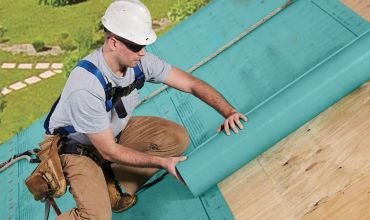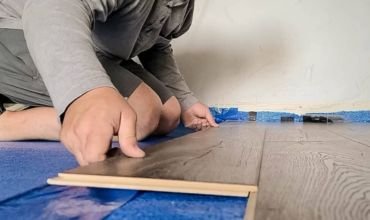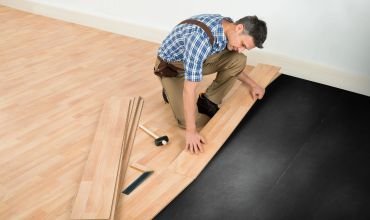When it comes to installing laminate flooring, one of the most frequently asked questions is whether you need an underlay. The answer is a bit nuanced, as the decision to use underlay depends on various factors such as the type of laminate, the subfloor, and your specific needs. In this blog, we’ll explore the purpose of underlay, its benefits, and whether it’s necessary for your laminate floor underlayment.
A thin layer of material called underlay also known as underlayment is positioned between the laminate flooring and the subfloor. Its main objective is to give the flooring a level and smooth surface. But underlay also fulfills several other crucial purposes as well.
Underlayment of your laminate flooring favors you with numerous advantages, with some of them being:

One of the key roles of underlay is to act as a moisture barrier. If your subfloor is prone to moisture such as concrete in basements using a moisture-resistant underlay can help protect the hardwood floor underlayment from warping or damage due to dampness.
Underlay can significantly reduce noise levels in a room. If you’re concerned about echoes or sound transmission between floors, especially in multi-story homes or apartments, an acoustic underlay can help dampen footsteps and other noises.
Some underlays provide thermal insulation, making your floor feel warmer underfoot. This is particularly beneficial in colder climates where you want to maintain a comfortable indoor temperature.
An underlay helps to smooth out minor imperfections in the subfloor, providing a more even surface for your laminate flooring. This can prevent issues such as gaps or buckling over time.
Underlay can provide a slight cushion underfoot, making the floor more comfortable to walk on. This is particularly important in areas where you spend a lot of time standing, such as kitchens.
Many laminate flooring products are designed for click-lock installation, which can be easier and faster with a proper underlay. It allows for better alignment and reduces the risk of damage during installation.

While there are many benefits to using underlay, whether you need it depends on several factors:
If your subfloor is made of plywood or oriented strand board (OSB), you may not need underlay, especially if it’s in good condition. However, if you have a concrete subfloor, an underlay is almost always recommended to provide moisture protection.
Some laminate flooring products come with built-in underlayment. These options eliminate the need for an additional layer, saving you both time and money. Always check the manufacturer’s guidelines before deciding.
In high-traffic areas or rooms where noise is a concern (like living rooms or bedrooms), using underlay can significantly enhance comfort and sound insulation.
In humid climates, a moisture-resistant underlay is crucial for protecting your laminate flooring. Conversely, in drier environments, it may be less of a concern.
If you’re using an underlayment for vinyl flooring method, an underlay is generally required to provide the necessary cushioning and moisture protection. However, glue-down methods might not need it, depending on the specific product.
If you decide that you do need underlay, there are several types to choose from:

This is the most common type and is suitable for many laminate floors. It offers good cushioning, and sound absorption, and is relatively inexpensive.
Made from recycled materials, the felt underlay provides excellent sound absorption and moisture resistance. It is often thicker than foam underlay, making it a good option for added comfort.
This is a more premium option that provides superior sound insulation and moisture protection. It is often used in high-traffic areas or commercial spaces.
Cork is a natural material that offers excellent thermal and acoustic insulation. It’s an eco-friendly choice and can be more expensive than other types.
If moisture is a concern, look for underlays that have built-in moisture barriers, often made from polyethylene or other moisture-resistant materials.
If you need the best underlayment for vinyl sheet flooring rough subfloor, the installation process is a critical step to ensure your new flooring performs well and lasts longer. Underlayment provides essential support, helps reduce noise, adds comfort underfoot, and can act as a moisture barrier. Even though it might seem like a simple task, improper installation can lead to issues like uneven floors, squeaks, and damage over time. Here’s a comprehensive guide on how to install underlayment for laminate flooring properly.
Clean the subfloor thoroughly, ensuring it’s free of dust, debris, or any uneven spots. Repair any cracks or imperfections.
Unroll the underlayment across the subfloor, starting from one corner of the room. Lay it out flat without overlapping the edges. If needed, cut the underlayment to fit around edges and corners using a utility knife.

Tape the seams between each underlayment sheet using underlayment tape to prevent them from shifting. Do not tape the underlayment to the subfloor itself.
If you’re installing over a concrete subfloor, ensure you lay down a moisture barrier or choose underlay with an integrated vapor barrier.
Once the underlayment is secured, you can begin installing your laminate flooring over the top, ensuring to follow the manufacturer’s guidelines for spacing and plank placement.
This simple process ensures a smooth, protected base for your laminate flooring.
With this, it is now possible that all your queries regarding what is underlayment are clear. underlayment is a crucial component for laminate flooring installation, offering benefits such as noise reduction, moisture protection, improved comfort, and a longer lifespan for your floor. Selecting the right type of underlay tailored to your needs ensures that your floor remains stable, comfortable, and well-protected for years to come.
Underlayment is a thin layer of material installed between a subfloor and a floor covering to provide a variety of benefits.
Many underlayment options exist in the market, but cement backer boards or underlayment for vinyl plank flooring is a good choice for most tile installations.
No, it is not necessary to have an underlay for vinyl as vinyl flooring itself can be completely self-sustainable and does not require an underlayment to function properly.
Sheet vinyl flooring fiber underlayment or other materials roughly costs around $4 to $8 for labor or installation process.
The time it takes to laminate floor underpayment depends upon the size and space of the flooring but usually, it ends up consuming 3-4 hours for a standard size.
Leave a Reply